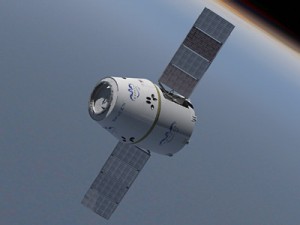Yesterday’s successful launch of SpaceX‘s Falcon 9 rocket and Dragon reusable spacecraft from Cape Canaveral in Florida, marked what NASA administrator Charles Bolden called “the beginning of a new era in exploration.”
Now that the Dragon is in space, technicians are testing its capability of rendezvousing and docking with the International Space Station, where it is set to deliver experiments, payloads and supplies later this week.
Before that happens, Dragon will perform a flyby of the space station this Thursday. From a distance of approximately 2.41 kilometers from the ISS, technicians will validate the operation of the spacecraft’s sensors and flight systems necessary for a safe rendezvous.
If everything checks out, the Dragon capsule will be cleared to rendezvous and berth with the ISS on Friday, May 25. The ISS crew will use the space station’s robotic arm to capture Dragon and install it on the bottom side of the Harmony node of the ISS.
Until recently, spaceflight has mostly been a function of major governments.
Modern private spaceflight began in 1980 with the European Space Agency’s creation of Arianespace, which produces, operates and markets the Ariane series of launch vehicles. Since 1984, Arianespace has conducted more than 240 commercial space launches.
Private involvement of spaceflight can also be traced back to the 1962 U.S. Communications Satellite Act, legislation which provided a pathway for corporations to own and operate their own satellites. However, those satellites were still sent into space by government-owned launch vehicles.
Since retiring its space shuttle program last year, NASA – the US space agency – has partnered with companies to deliver crew and cargo to the ISS.

Artist rendering of Orbital's Cygnus spacecraft approaching the International Space Station. (Image: Orbital)
Two private companies, SpaceX, and Orbital Sciences are currently partnered with NASA’s Commercial Orbital Transportation Services (COTS) program to deliver cargo to the ISS.
Along with the SpaceX Dragon reusable spacecraft, Orbital Sciences is developing a vehicle that will also deliver supplies and other material to the ISS. Its Cygnus spacecraft is an expendable space capsule and is expected to launch its demonstration mission to the ISS sometime later this year.
A program called Commercial Crew Development (CCDev) has been established and is being run by NASA to attract companies that would develop privately-operated crew vehicles to ferry crew members to and from the ISS and other destinations in low-Earth orbit.
SpaceX, Boeing, Blue Origin and Sierra Nevada Corporation (SNC) are among the companies NASA is considering for this program. NASA hopes to launch the first CCDev missions that will transport ISS crew members in 2017.






















Comments are closed.